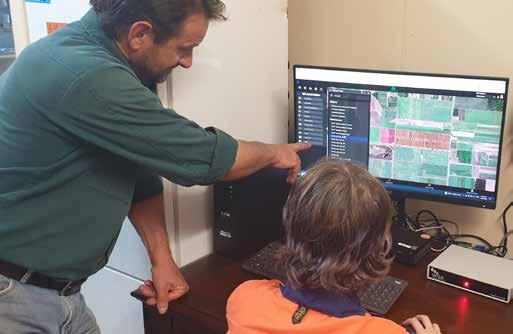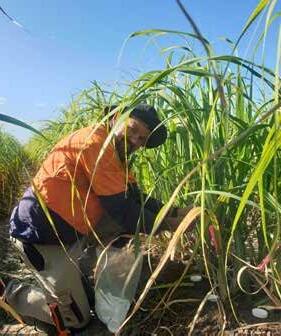
4 minute read
THE BURDEKIN IRRIGATION PROJECT: REDUCING WATER AND ENERGY COSTS
BY SRA
PROJECT OFFICER – IRRIGATION, ARMIN WESSEL
Advertisement
Steve Pilla is a Burdekin canefarmer, who runs both his own hectare farm and his mother’s farm some 14 km away, on his own.

In the past he had a farmhand to help him with daily operations but finding reliable labour and covering the cost of that labour got harder and harder.
When he heard about the Burdekin Irrigation Project (BIP) he was stretched. Irrigation was too often run on the side while he concentrated on getting other time-critical farm-work completed.
But Steve understood that the BIP would take some of the repetitive irrigation work out of his daily schedule and help him reduce water and energy costs while maintaining or improving productivity. He was also hoping to avoid the need to change irrigation sets at night and on weekends. So he made time to get involved.
Automation benefits
Now that the irrigation system is automated, he doesn’t want to go back to the old ways. Steve can plan a whole irrigation sequence in advance when he has spare time. He chooses the pumps that are needed to supply the water and the sets he wants to irrigate in his new sequence. IrrigWeb (irrigation scheduling and record keeping software) tells him when to set a start time for each sequence and the run times for each set.
When it is time to irrigate, the WiSA base station sends radio signals to the equipment on farm so the pre-planned irrigation event can be executed. Integrated safety features like pressure sensors make sure that either an alarm is sent to Steve or the system is immediately shut down if any hardware fails and system pressure goes beyond pre-set limits. When he used the system for the first time, Steve went out to check in the paddock that everything went to plan but soon accepted that his automation system was keeping a closer eye on things than he could. In the past he would notice if something went wrong when he started the irrigation system manually but if the fluming burst during the day he would only notice the damage when he got back to change a set. Now the automation system constantly monitors and can shut down the system or send alarms to Steve when he is elsewhere.
Crop demand model
The need for irrigation is determined by IrrigWeb that tracks crop demand, uses local rainfall, soil and weather data and calculates when the next irrigation should be applied. The software then records the applied irrigation and starts the calculation process for the next irrigation.
Once a week, Steve receives an automated Irrigweb email with a list of the sets that will require irrigation over the next seven days, so he can set up irrigation sequences accordingly.
Set durations are optimised using end of row sensors to minimise tailwater loss. Start times are planned with the help of Irrigweb. The planning process is done at a convenient time by Steve or his daughter while the automation system executes the commands when the crop needs irrigation.
Gone are the days where a strict 12-hour shift system was the norm and irrigation tasks were constantly interfering with daily routines.
BIP demonstration site
Steve has a history of trial involvement with SRA, loving to learn first-hand from the outcomes.
He was happy to host a BIP demonstration site, wanting to understand how he could improve his practices and share the knowledge gained in the process. Replicated strip trials were set up on his farm to demonstrate differences between irrigation volumes and scheduling.
Measurement of irrigation volumes, irrigation progress, runoff loss and soakage are measured by smart tools including advance sensors, tensiometers, and flumes. The data is then analysed by the BIP team. The economic outcomes of different irrigation treatments will be evaluated at the end of the project.
Deep drainage losses
Steve hopes to learn how to minimise deep drainage losses.
He has had to install subsoil drainage in the past to combat wet spots caused by shallow localised groundwater tables. One of his blocks was partially deep ripped a decade ago and ever since has a history of excessive deep drainage losses. This localised problem might be lessened with higher inflow and shorter duration irrigation events.
With the use of automation, shorter irrigation durations with higher flows do not upset the daily farm routine. And water is no longer draining through a leaky profile and adding to rising groundwater tables.
Help with irrigation
Since the irrigation system has been automated, Steve`s daughter has been able to help on the farm while not being physically present.
She has just finished her Bachelor of Business and is now working off farm. However, to help Steve out, she has the flexibility to plan and set up whole irrigation sequences online, at a time to suit her. As a result, she is able to become part of the farming team from anywhere in Australia (or the world). Steve is then able to respond on farm, if alerts flag something that needs attention.
Life changing
After using the new irrigation system for a couple of months and overcoming initial teething issues, Steve has confidence that the system will do the right thing.
“We included pressure sensors as safeguards, just in case,” he said. “I trust that it all works and if there is an issue, I will receive an alert on my phone.
“I no longer need to check the irrigation daily, and that’s saved me valuable time. It’s changed my working day.”
Scan to read Burdekin Irrigation Project FAQs
If you would like to learn more about the activities of the Burdekin Irrigation Project please contact SRA District Manager for the Burdekin, Terry Granshaw, email: tgranshaw@sugarresearch.com.au or SRA Environmental Sustainability Scientist Simon Clarke, email: sclarke@sugarresearch.com.au











